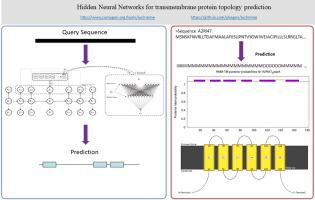当前位置:
X-MOL 学术
›
Comput. Struct. Biotechnol. J.
›
论文详情
Our official English website, www.x-mol.net, welcomes your
feedback! (Note: you will need to create a separate account there.)
Hidden neural networks for transmembrane protein topology prediction
Computational and Structural Biotechnology Journal ( IF 4.4 ) Pub Date : 2021-11-08 , DOI: 10.1016/j.csbj.2021.11.006 Ioannis A Tamposis 1 , Dimitra Sarantopoulou 2, 3 , Margarita C Theodoropoulou 1 , Evangelia A Stasi 1 , Panagiota I Kontou 1 , Konstantinos D Tsirigos 4 , Pantelis G Bagos 1
Computational and Structural Biotechnology Journal ( IF 4.4 ) Pub Date : 2021-11-08 , DOI: 10.1016/j.csbj.2021.11.006 Ioannis A Tamposis 1 , Dimitra Sarantopoulou 2, 3 , Margarita C Theodoropoulou 1 , Evangelia A Stasi 1 , Panagiota I Kontou 1 , Konstantinos D Tsirigos 4 , Pantelis G Bagos 1
Affiliation

|
Hidden Markov Models (HMMs) are amongst the most successful methods for predicting protein features in biological sequence analysis. However, there are biological problems where the Markovian assumption is not sufficient since the sequence context can provide useful information for prediction purposes. Several extensions of HMMs have appeared in the literature in order to overcome their limitations. We apply here a hybrid method that combines HMMs and Neural Networks (NNs), termed Hidden Neural Networks (HNNs), for biological sequence analysis in a straightforward manner. In this framework, the traditional HMM probability parameters are replaced by NN outputs. As a case study, we focus on the topology prediction of for alpha-helical and beta-barrel membrane proteins. The HNNs show performance gains compared to standard HMMs and the respective predictors outperform the top-scoring methods in the field. The implementation of HNNs can be found in the package JUCHMME, downloadable from , . The updated PRED-TMBB2 and HMM-TM prediction servers can be accessed at .
中文翻译:

用于跨膜蛋白拓扑预测的隐藏神经网络
隐马尔可夫模型 (HMM) 是生物序列分析中预测蛋白质特征的最成功的方法之一。然而,存在马尔可夫假设不充分的生物学问题,因为序列上下文可以为预测目的提供有用的信息。为了克服 HMM 的局限性,文献中出现了几种 HMM 的扩展。我们在这里应用一种结合了 HMM 和神经网络 (NN) 的混合方法,称为隐藏神经网络 (HNN),以直接的方式进行生物序列分析。在此框架中,传统的 HMM 概率参数被 NN 输出取代。作为一个案例研究,我们重点关注 α 螺旋和 β 桶膜蛋白的拓扑预测。与标准 HMM 相比,HNN 显示出性能提升,并且各自的预测器优于该领域的最高评分方法。 HNN 的实现可以在 JUCHMME 包中找到,可以从 、 下载。更新后的 PRED-TMBB2 和 HMM-TM 预测服务器可在 访问。
更新日期:2021-11-08
中文翻译:

用于跨膜蛋白拓扑预测的隐藏神经网络
隐马尔可夫模型 (HMM) 是生物序列分析中预测蛋白质特征的最成功的方法之一。然而,存在马尔可夫假设不充分的生物学问题,因为序列上下文可以为预测目的提供有用的信息。为了克服 HMM 的局限性,文献中出现了几种 HMM 的扩展。我们在这里应用一种结合了 HMM 和神经网络 (NN) 的混合方法,称为隐藏神经网络 (HNN),以直接的方式进行生物序列分析。在此框架中,传统的 HMM 概率参数被 NN 输出取代。作为一个案例研究,我们重点关注 α 螺旋和 β 桶膜蛋白的拓扑预测。与标准 HMM 相比,HNN 显示出性能提升,并且各自的预测器优于该领域的最高评分方法。 HNN 的实现可以在 JUCHMME 包中找到,可以从 、 下载。更新后的 PRED-TMBB2 和 HMM-TM 预测服务器可在 访问。











































 京公网安备 11010802027423号
京公网安备 11010802027423号